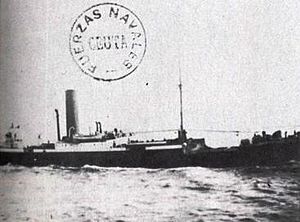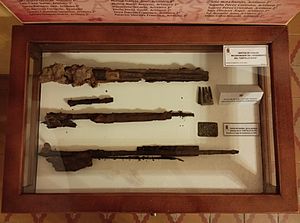SS Castillo de Olite facts for kids
Castillo de Olite was a large cargo ship that started its life in 1920 in the Netherlands. It was first named Zaandijk. Over the years, it had many different owners and names, including Zwartewater, Postyshev, and Akademik Pavlov. In 1938, during the Spanish Civil War, a group called the Spanish Nationalists took control of the ship and renamed it Castillo de Olite. Sadly, in the final days of the war, the ship was sunk while carrying soldiers, leading to a very large loss of life.

Official photo of Castillo de Olite
|
|
Quick facts for kids History |
|
|---|---|
| Name |
|
| Namesake |
|
| Owner |
|
| Operator |
|
| Port of registry | |
| Builder | De Rotterdamsche Droogdok Maatschappij NV, Rotterdam |
| Yard number | 69 |
| Laid down | 2 April 1920 |
| Launched | 20 November 1920 |
| Completed | 19 February 1921 |
| Identification | |
| Fate | Sunk by gunfire, 7 March 1939 |
| General characteristics | |
| Type | cargo ship |
| Tonnage | 3,545 GRT, 2,150 NRT |
| Length | 110.1 m (361.3 ft) |
| Beam | 15.2 m (49.8 ft) |
| Draught | 6.60 m (21 ft 8 in) |
| Depth | 6.7 m (22.0 ft) |
| Installed power | 342 NHP |
| Propulsion | triple-expansion engine |
| Speed | 10 knots (19 km/h; 12 mph) |
| Armament |
|
Contents
Building a Ship
The ship was built by a company called De Rotterdamsche Droogdok Maatschappij NV in Rotterdam, a city in the Netherlands. It was launched into the water on November 20, 1920, and finished being built on February 19, 1921.
The ship was quite large. It was about 361 feet (110 meters) long. Its width, called the beam, was almost 50 feet (15 meters). The depth of the ship was 22 feet (6.7 meters). It was designed to carry goods, so it was known as a cargo ship.
The Castillo de Olite had one propeller. This propeller was powered by a special steam engine. This engine could produce 342 horsepower, which helped the ship move through the water.
A Ship with Many Names
The ship had several different names throughout its history.
Early Owners and Names
When the ship was first built, its name was Zaandijk. Its first owner was a company called NV Solleveld, Van der Meer & TH van Hattum's Stoomvaart Maatschappij. The ship was registered in Rotterdam, Netherlands. It sailed to places like Java and Sumatra to trade goods.
In 1930, another company, NV Stoomvaart Maatschappij "Nederlandsche Lloyd," bought the ship. They changed its name to Zwartewater. It was still registered in Rotterdam at this time.
Soviet Ownership
In 1935, the USSR bought the ship. They renamed it Postyshev, after a Ukrainian Communist named Pavel Postyshev. The ship was then registered in Odesa, a city in the Soviet Union. In 1938, its name was changed again to Akademik Pavlov.
Capture by Nationalists
On May 31, 1938, during the Spanish Civil War, a Nationalist ship captured Akademik Pavlov. This happened near the Strait of Gibraltar. The ship was carrying a cargo of coal at the time.
After being captured, the ship became part of the Nationalist Spanish Navy. They renamed it Castillo de Olite. They also added weapons to it. It was armed with a 120 mm Vickers gun and a 57 mm Nordenfeldt gun.
The Sinking of the Ship
The sinking of Castillo de Olite was a very sad event that happened in the final days of the Spanish Civil War.
The Situation in Cartagena
At that time, Cartagena was one of the last places still controlled by the Republican side. Most of the remaining Republican Navy ships were in its harbor. An uprising against the Communists began in Cartagena. Because of this, the Nationalists decided to send help to try and take control of Cartagena and the Republican fleet.
The Convoy and the Attack
The Nationalists quickly put together a group of 16 ships. These ships were carrying more than 20,000 soldiers. The convoy included several minelayers, auxiliary cruisers, and transport ships, including the Castillo de Olite.
The Republican fleet had left Cartagena and sailed to Oran, in Algeria. However, a Republican army group had taken back control of the port and its coastal defense cannons. This meant the Nationalist ships could not land their troops.
Most of the Nationalist ships turned around and left. But the Castillo de Olite did not get the order to leave. Its radio was not working. As the ship got closer to the docks, one of the large cannons on the coast fired a shell. The shell hit the Castillo de Olite. The ship broke into two pieces and sank very quickly.
Loss of Life
There were 2,112 men on board the Castillo de Olite when it sank. Sadly, 1,476 of them died. Another 342 were injured. Only 294 men were saved. Local fishermen and the lighthouse keeper, Santiago Saavedra, and his wife, Carmen Hevia, helped rescue them.
This event was one of the biggest losses of life from a single ship sinking in Spanish history.
See also
 In Spanish: Castillo de Olite (1938) para niños
In Spanish: Castillo de Olite (1938) para niños


